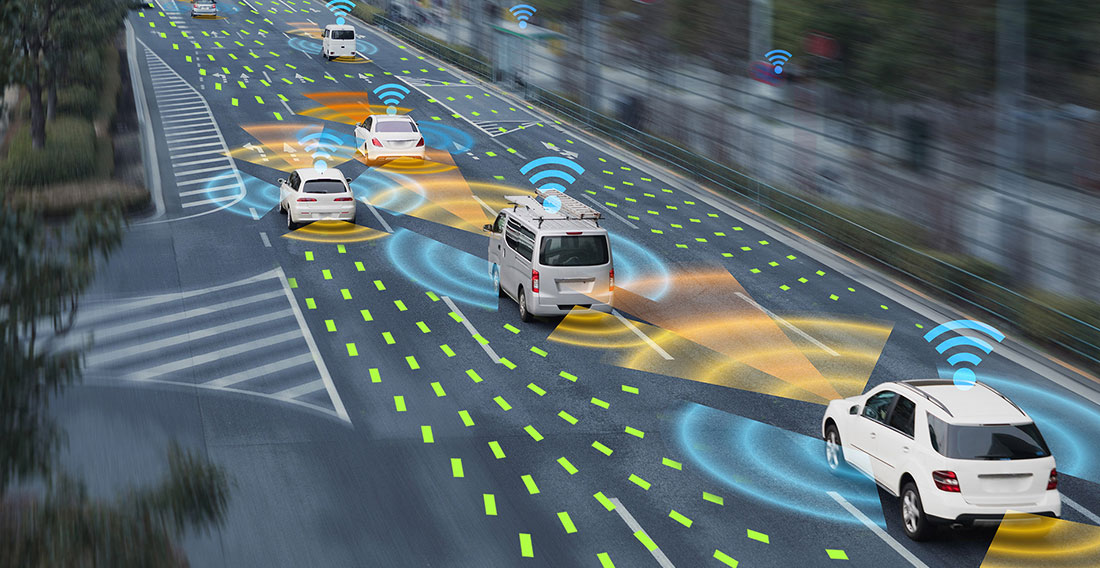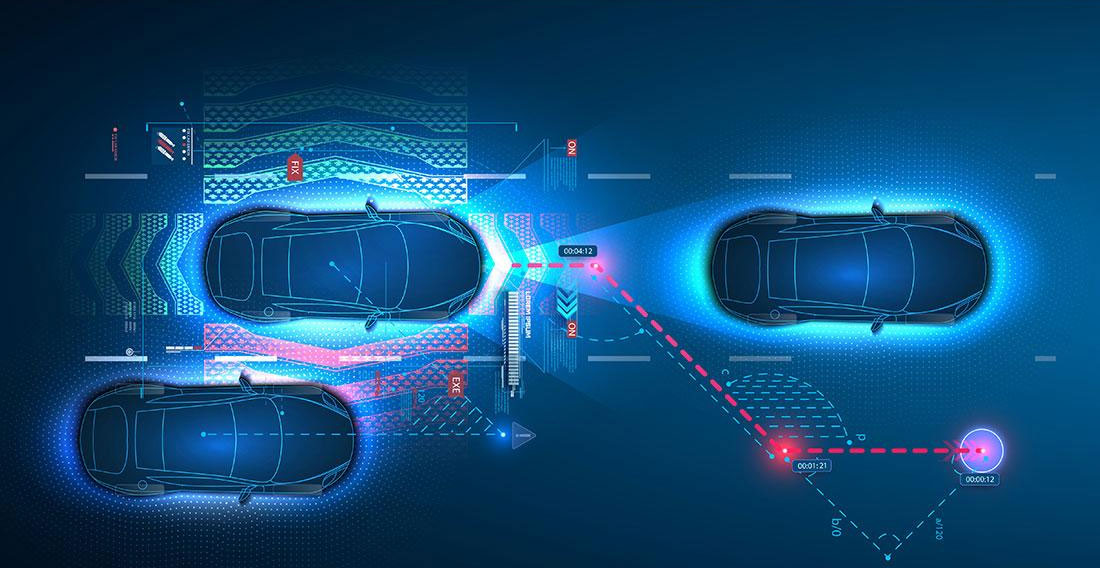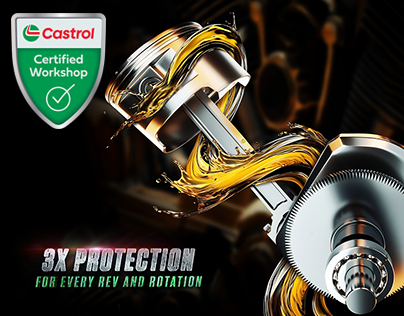Get a quote today
Are you looking for ADAS Calibration for your vehicle?
Priorslee Motor Services Advanced Driver Assistance Systems (ADAS) Calibration Service
What is ADAS?
Designed to provide safety and comfort while driving, Advanced Driver Assistance Systems (ADAS) are becoming ever more common in the latest generation of vehicles. It is thought that 60% of all cars manufactured since 2018 have at least one ADAS system fitted.
ADAS is designed to avoid collisions and accidents by offering technologies that alert the driver to potential problems, or to avoid collisions by implementing safeguards and taking control of the vehicle. Some examples include autonomous emergency braking, adaptive cruise control, lane departure and pedestrian and traffic sign recognition.
What are the different ADAS systems?
ADAS covers a wide range of driver assistance systems. Each type of ADAS may have a slightly different name depending on the manufacturer, but some of the key types include:
Adaptive Cruise Control
Despite cruise control being first introduced as early as the 1940's it has seen some high-tech advantages in recent years. Adaptive Cruise Control (ACC} can sustain a set speed, like traditional cruise control, but can adjust this speed based on traffic movement, too. Cars fitted with ACC will use radar, or sometimes cameras, to detect obstacles and other vehicles nearby and automatically accelerate or decelerate accordingly.
Autonomous Emergency Braking
As with ACC, Autonomous Emergency Braking (AEB) works via sensors that scour the road ahead for obstacles. ACC and AEB will often share the same sensors, although some systems include cameras that can see cyclists and pedestrians at the edge of the road. The AEB system will then warn of the approaching hazard with dashboard lights and an alarm, before operating all-out braking force if you don't react.
Forward Collision Warning
Like Autonomous Emergency Braking, Forward Collision Warning or FCW detect potential obstacles in the road ahead and alert you with a warning on the dashboard. Some FCW systems also assist the driver such as by boosting the braking input to increase the likelihood of avoiding an accident. The main difference between the two systems is that the driver has to take initial action and respond to the warning with FCW whereas AEB systems take action automatically.

Lane Departure Warning
This technology is already fitted in many newer vehicles. However, it is being further improved to make sure that cars aren't steered out of the lane they're in. In some situations, an alert (i.e. a pulse through the steering wheel) is given to the driver and in other instances; the vehicle will lightly steer to keep the car in the lane. This is known as Lane Keep Assist Systems or LKAS. This is especially useful on dual carriageways and motorways where driving can become monotonous.
Blind Spot Detection
Blind spot detection is already accessible in various forms. This can be as straightforward as a light on the wing mirror that shows that a vehicle is sitting in your blind spot. Other blind spot detection features stop you from driving into another lane if there's a chance you'll hit a vehicle you can't see. This is especially
beneficial for drivers with limited mobility who can't physically turn around to check their blind spots.
Road Sign Detection
A road sign detection system has a forward-facing camera which searches the road ahead for road signs. This camera is hooked up to character recognition software which reads any changes illustrated by the sign. It then relays this on to the vehicle's instrument panel. The data stays there until any changes occur.
So, if you're uncertain of the speed limit, all you have to do is look at the information that the car observes. This might seem quite basic, but the technology might stop you from inadvertently speeding and encourages you to keep your eyes on the road.
Park Assist
This was once a feature only seen with 'premium' brand cars, but park assist, or automatic parking, is increasingly being made available to all manufacturers. We have all faced parking challenges, and parallel parking, in particular, can cause a lot of stress! Self-Parking technology goes one step ahead of technology such as parking sensors by discovering spaces, and then-with some help from the driver-parking your vehicle into that space for you.
What are the current 5 sensors that make ADAS work?
Key Types of ADAS Sensors in Use Today
- Video cameras.
- SONAR (aka Ultrasound)
- RADAR.
- LiDAR.
- GPS/GNSS sensors (satellite interface)

ADAS Calibration
To do their jobs, ADAS rely on inputs from a variety of sensors that allow the systems to "see" what is happening around the vehicle. The most common are cameras and ultrasonic sensors. Steering sensors are also used to help determine the direction of vehicle travel. Some systems use information from a single type of sensor, but others combine information from multiple sensors to obtain a more accurate "view" of the vehicles situation.
Every time a piece of body work, including the front and rear windows, needs replacing or repairing, the ADAS systems within those parts of the vehicle will need to be re-calibrated to ensure they continue working as expected on the roads.
A misaligned camera could lead to incorrect readings and ultimately an accident. Considering that sensors can be found on almost every side of a vehicle, any work done will usually result in the ADAS system requiring re-calibration.
What does ADAS mean for Car Maintenance?
The increase in complexity does come with additional maintenance for vehicles fitted with ADAS. The advanced systems use hardware such as radar, ultrasonic sensors, cameras or in some cases a combination, which will all require calibration after certain work or repairs have been performed.
Examples of work that will require ADAS calibration include:
- Wheel alignment
- Suspension work including shock absorber or spring replacement
- Headlamp alignment
- Windscreen replacement
It is also vital that whenever ADAS is calibrated then four wheel alignment must also be checked and corrected if necessary. If the wheels aren't aligned correctly then the vehicle will not be travelling where the electronics think it should be which could cause a fault light or even for the system to fail to operate when needed.
The Effects of Alignment on ADAS
By having your wheels correctly aligned you benefit from a more even wear and a longer life span for your tyres. Wheel alignment problems are often caused by hitting a pothole or kerb, in turn placing an increased load on steering and suspension components.
Vehicle suspension misalignment can result in rapid irregular tyre wear, poor handling and reduced vehicle safety and occurs when the suspension and the steering system are not working at their correct angles.
In relation to ADAS, when your wheel alignment is misaligned the direction which the ADAS sensors project is warped (see diagram below).
Vehicles equipped with ADAS, especially lane departure and emergency braking, need to be properly aligned with how the vehicle is traveling down the road. Cameras and sensors use different inputs from the vehicle, such as the steering angle sensor.
If the steering angle sensor is adjusted during a wheel alignment, the forward-facing camera, which controls the lane departure warning, may think the steering wheel is turned. This can signal the vehicle to correct the steering to stay on the road, even though the vehicle is traveling between the lines.
Frequently Asked Questions
Q: How can I tell if my ADAS is working correctly?
Currently different manufacturers indicate the ADAS functionality check when the vehicle is first started, or the type of system is activated/deployed. For instance, if the camera in the windscreen is obscured, or not currently accepting information, then a message in the driver info centre will indicate the camera is blocked. Similarly with other systems on the vehicle, warning information will be displayed for ACC etc.
Q: After o four-wheel alignment check with adjustments, will the ADAS require a calibration?
If the vehicle is fitted with any type of forward facing, body mounted Radar {ACC, City Safety, Distronic etc) then the Vehicle Manufacturers Method Statement should be followed and if required, a calibration checked and recalibrated, with the issue of a relevant Calibration certificate, copies of which should be retained by the workshop for future reference.
Q: Is there a legal requirement that the ADAS needs to be functioning correctly?
The automatic braking system is only one of the many ADAS fitted on vehicles today. In this respect, the European Parliament has already approved the proposal to make driver assistance systems mandatory on all new type-approved vehicles as soon as possible. As a mandatory fitted safety system it is envisaged that the system will have to be checked for any warning indicators for test purposes, as are ABS and Airbag.
Q: If the ADAS isn't working correctly, how could this affect the vehicles performance?
To do their job, ADAS systems rely on inputs from a variety of sensors that allow them to "see" what is happening around the vehicle. The most common are camera, radar, laser, lidar and ultrasonic sensors. Steering sensors are also used to help determine the direction of vehicle travel. Some systems use information from a single type of sensor, but others combine information from multiple sensors - a process called sensor fusion -to obtain a more accurate "view" of the situation.
Most ADAS sensors are very precisely aimed and require calibration if their positions are disturbed in any way. Consider that a sensor out of alignment by a fraction of an inch or even one degree on the vehicle will be aimed at an area significantly off axis 50 or more metres down the road. Misaimed sensors often result from collisions - even a minor accident can knock ADAS sensors out of alignment. However, calibration can also be required as a by-product of common vehicle service work such as windscreen replacement, suspension repair or wheel alignment.
If there are issues with any speed related signal, then the ADAS and other systems will be disabled. Many ADAS systems can be activated/deactivated by the driver, through the Infotainment Centre and optional switches.
Q: Is it true that ADAS is only fitted to prestige vehicles?
The United Nations Economic Commission for Europe (UNECE) has announced that the Advanced Emergency Braking Systems
(AEBS) will be mandatory for all new cars from 2020. To achieve NCAP rating for insurance purposed, ADAS options are available on all makes & models.
Q: When buying a used vehicle with ADAS fitted, should I ask for a calibration certificate?
If the vehicle has been repaired following body damage, wheel alignment adjustment or a replacement windscreen, there should be an available certificate to confirm the calibration. This is where a Full-Service History is vital for customers buying any used car with ADAS. New vehicles are not supplied with any certification but are produced to a homologated standard with the appropriate software installed to support the hardware. Any changes to compensate for wear and tear should therefor carry any available documentation.
Q: Who can calibrate ADAS and should they be licenced?
Workshops investing in ADAS calibration systems predominantly send their technical staff to the training centres for IMI Certified training. Moving forward, there will become a greater level of technology employed in the average motor vehicle and owners must be careful of using suitably equipped repairers to have their vehicles repaired and serviced. Licencing is not currently a UK requirement for workshops, but with the increases is safety systems and the technology required to service, repair and maintain these vehicles it is becoming a necessity.



